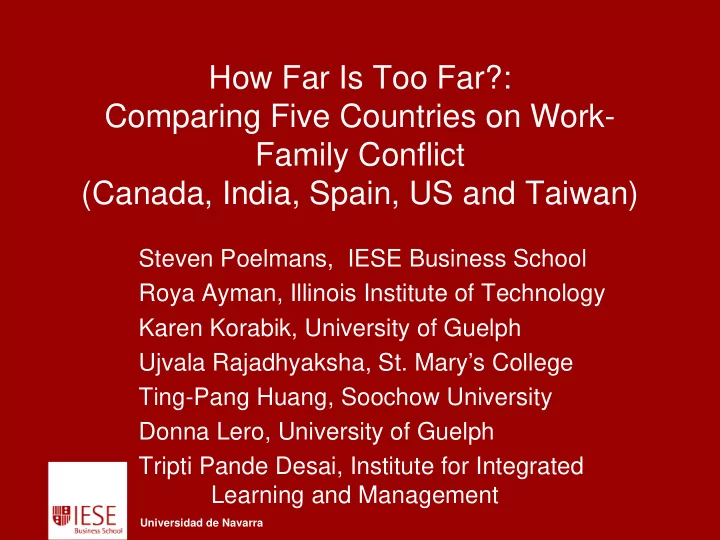

How Far Is Too Far?: Comparing Five Countries on Work- Family Conflict (Canada, India, Spain, US and Taiwan) Steven Poelmans, IESE Business School Roya Ayman, Illinois Institute of Technology Karen Korabik, University of Guelph Ujvala Rajadhyaksha, St. Mary’s College Ting-Pang Huang, Soochow University Donna Lero, University of Guelph Tripti Pande Desai, Institute for Integrated Learning and Management Universidad de Navarra
Purpose • To compare the five countries (US, Canada, Spain, Taiwan and India) using preliminary data from a multinational study of WFC (Project 3535). • The USA and Canada are similar in culture, the economic development of women, and the presence of workplace and institutional supports. The same is true for Taiwan and India. Spain is expected to be in between, as it is transitioning from more traditional to more egalitarian gender role ideology, and from collectivism to individualism. • Therefore, we expect differences between North American and Asian countries on WFC and on its relationship to cultural variables, specifically gender-role ideology (GRI) and individualism/collectivism (I/C). Universidad de Navarra
Sample Descriptives Category Canada n=276 India n=228 Spain n=148 US n=62 Taiwan n=121 Gender(%): 19 Male 61 23 42 21 81 Female 39 77 58 79 Mean Age 40 36 39 41 38 Mean # of Children 2.11 1.45 1.86 2.37 1.77 Position (%): Managerial 49 39 61 46 54 Non-Managerial 51 61 39 54 46 Sector (%): Education 14 18 32 5 6 Manufacturing 40 24 47 0 23 Health 0 30 13 89 38 Finance 5 28 7 3 33 Other 41 1 2 3 Universidad de Navarra
Multivariate Analysis of Cultural Values Country- F (28, 731) = 26.47** GRI VC VI HI @ HC @ HI @ HC @ 297.42** 11.99** 47,11** Home Home Work Work 9.45** 37.34** 6.54** 7.09** Spain a* Taiwan a India a US a Spain a India a Spain a US a India b Taiwan b India b US b US a US b Canada a Spain c Canada c Spain c Canada b Canada b Taiwan b Taiwan b US c US d Canada c Taiwan b Spain b India b India c* Canada c Spain d Taiwan c India c Taiwan b Canada c Rankings of countries from high to low; a is the highest and d the lowest; Countries with the same letter are not significantly different from each other. Universidad de Navarra
Effects of Country on WFC Variables WIF FIW US a India a Canada a Taiwan b India b Canada b Spain b Spain b Taiwan c US b Rankings of countries from high to low; a is the highest and d the lowest; Countries with the same letter are not significantly different from each other. Universidad de Navarra
Effects of Country & GRI on WFC Two significant main effects 1. As previously discussed countries differed in WIF and FIW 2. GRI was significantly related to both WIF and FIW: - Those with traditional GRI had higher WIF and FIW No significant interaction effect between country and GRI Universidad de Navarra
Conclusions • Country and cultural values affected WFC variables separately but not in interaction with each other. • Individuals with egalitarian gender role beliefs will experience less work family conflict than those with traditional beliefs. • For most cultural values, Asian countries clustered together as did the North American countries. However, Spain was not always in between the two. • North American countries were highest on WIF and India was highest on FIW. Universidad de Navarra
spoelmans@iese.edu Thank you. Universidad de Navarra
Recommend
More recommend